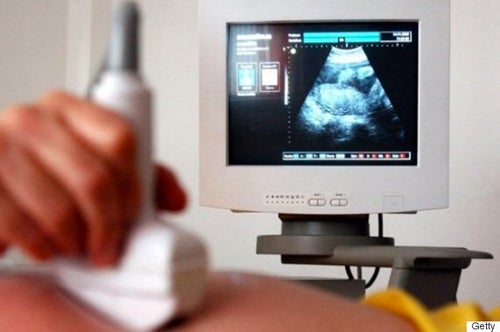If you are pregnant or are thinking of getting pregnant and do not want to know the gender of your baby, you MUST NOT READ THIS ARTICLE.
Go away. Read something else. Go on. Go! I'm waiting.... Seriously. You can't read this.... Er... are you still there? No? Good. OK. Now, to the rest of you.
For centuries, people have been claiming they can predict the gender of your baby whilst you are still pregnant. Some say that you're having a boy if you're carrying all out front or low and a girl if you're carrying all around and high.
Or there's the old 'wedding ring over the belly' trick - if you tie your wedding ring onto a string and hold it over your belly, apparently the way it swings can tell the gender - if it moves in circles it's a boy, side to side it's a girl.


Other gender predictors include the state of your skin or your hair, your mood, whether or not you had morning sickness, the shape of your nose, the colour of your urine, the exact age you were when you conceived, even the position you were in when you got pregnant. Unfortunately, for anyone who has wanted to actually find out what sex their baby is, none of these old wives tales or gender predictors have any bearing in reality whatsoever. They may be fun to do, but they aren't going to give you any clear cut answers.Ultrasound scans finally made it possible to see whether you were having a girl or a boy. Until fairly recently, one would have to wait until the 20 week scan or later to see the genitals clearly. 20 weeks, of course, is a long time to wait if you really, really want to know.
Now though, research is being done into whether or not the gender of a fetus is obvious at the 12 week scan. At the moment, most sonographers will say that they cannot tell you the gender of your baby at your first scan. This is, perhaps, because they aren't aware of 'the nub theory'.
The nub theory is basically about 'the angle of the dangle'. Between 11 and 14 weeks' gestation both genders have a penis-like protuberance between the legs. They look incredibly similar at this point, except for the angle at which they are pointing. Sometimes there are males and females at this stage which are in the 'grey area', but essentially a boy's 'dangle' is 30 degrees up relative to the backbone and a girl's is below 30 degrees.
In order to be able to have any chance of predicting the gender, the foetus must not be curled up- they need to be lying as flat as possible. Also, it must be side on and apparently, it is better if the foetus is right side up.
OK, here are some examples. First, my soon to be born little boy at 12 weeks. I've put a red arrow in pointing to his 'nub', which as you can see is pointing 'up'. Some male foetus shots I've seen have been pointing almost straight up.
Nub theory: How to predict your baby's gender from the 12 week scan
Here is a shot of a girl. You can see her nub is pretty much horizontal. You can also see that her nub looks forked at the end. Some people think this means it is more likely that it is a girl, but a fork can be seen in both genders.
If you get your scan at 11 weeks, it can be difficult to tell the difference between the genders. A scan at 12 weeks is around 75% accurate and at 13 weeks it's closer to 95% accurate.
When you go in for your scan, ask your sonographer to get a shot exactly like one of the ones above- the foetus right side on, back flat not curled up and a good shot of the 'nub'.
There is loads of information online about the nub theory. This site has photographs showing the differences between the genitals and includes examples of ultrasound images.
If you've already had your scan and the nub is visible, but you can't work out if it's a boy or a girl, why not go to the In Gender Forum where you can post up your scan on the boards and get members to have a look and make their predictions. There are also threads on which members post up their scans AFTER the gender has been confirmed either at the 20 week scan or at birth.
For more information on finding out the sex of your baby, visit NHS Choices.